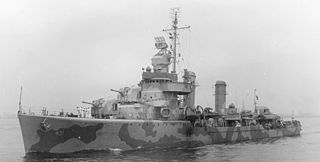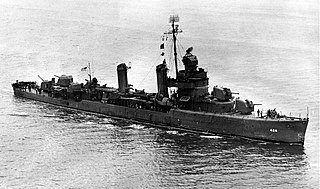
USS Cole (DD-155) was a Wickes-class destroyer in the United States Navy during World War II, later reclassified as AG-116. It was named for Edward B. Cole, a United States Marine Corps officer who died as a result of the wounds he received at the Battle of Belleau Wood.

USS Schenck (DD-159) was a Wickes-class destroyer in the United States Navy during World War II. She was named for Rear Admiral James F. Schenck, USN (1807–1882).

USS Herbert (DD-160) was a Wickes-class destroyer. She was named for Hilary A. Herbert (1834–1919), Secretary of the Navy from 1893 to 1897.

USS Tarbell (DD–142) was a Wickes-class destroyer in the United States Navy during World War I. She was the first ship named for Captain Joseph Tarbell.

USS Greer (DD–145) was a Wickes-class destroyer in the United States Navy, the first ship named for Rear Admiral James A. Greer (1833–1904). In what became known as the "Greer incident," she became the first US Navy ship to fire on a German ship, three months before the United States officially entered World War II. The incident led President Franklin D. Roosevelt to issue what became known as his "shoot-on-sight" order. Roosevelt publicly confirmed the "shoot on sight" order on 11 September 1941, effectively declaring naval war against Germany and Italy in the Battle of the Atlantic.

USS Du Pont (DD–152) was a Wickes-class destroyer in the United States Navy during World War II, later reclassified as AG-80. She was the second ship named for Rear Admiral Samuel Francis Du Pont.

USS Parrott (DD-218) was a Clemson-class destroyer in the United States Navy during World War II and was the second ship named for George Fountain Parrott.

USS Simpson (DD-221/APD-27/AG-97) was a Clemson-class destroyer in the United States Navy during World War II. She was the first ship named for Rear Admiral Edward Simpson.

USS McCormick (DD-223/AG-118) was a Clemson-class destroyer in the United States Navy during World War II. She was named for Lieutenant, junior grade Alexander McCormick, Jr.

USS Truxtun (DD-229) was a Clemson-class destroyer in the United States Navy during World War II. She was the third ship named for Thomas Truxtun.

USS Paul Jones (DD-230/AG–120) was a Clemson-class destroyer in the United States Navy during World War II. It was the third ship named for John Paul Jones.

USS Goff (DD-247) was a Clemson-class destroyer in the United States Navy during World War II. She was named for Secretary of the Navy Nathan Goff, Jr.

USS Plunkett (DD-431), a Gleaves-class destroyer, is the only ship of the United States Navy to be named for Rear Admiral Charles Peshall Plunkett.

USS Kearny (DD-432), a Gleaves-class destroyer, was a United States Navy warship during World War II. She was noted for being torpedoed by a German U-boat in October 1941, before the U.S. had entered the war. She survived that attack, and later served in North Africa and the Mediterranean.

USS Woolsey (DD-437), a Gleaves-class destroyer, was the second ship to be named Woolsey in the United States Navy. It is the first to be named for both Commodore Melancthon Brooks Woolsey and his father Commodore Melancthon Taylor Woolsey.

USS Ericsson (DD-440), a Gleaves-class destroyer, was the third ship of the United States Navy to be named after John Ericsson, who is best known for devising and building the Civil War ironclad USS Monitor.

USS Nicholson (DD-442), a Gleaves-class destroyer, was the third ship of the United States Navy to be named for the Nicholson family, which was prominent in the early history of the Navy. The destroyer saw service during World War II in the Atlantic, Mediterranean and Pacific theaters. Following the war, the ship was placed in reserve and used as a training ship. In 1951, the destroyer was transferred to Italy and renamed Aviere. In service with the Marina Militare until 1975, Aviere was sunk as a target ship in 1975.

The third USS Decatur (DD-341) was a Clemson-class destroyer in the United States Navy following World War I. She was named for Stephen Decatur.

USS Madison (DD-425) was a Benson-class destroyer in the United States Navy during World War II. She is the third Navy ship of that name, and the first named for Commander James J. Madison (1888–1922), who was awarded the Medal of Honor during World War I.

USS Charles F. Hughes (DD-428) was a Benson-class destroyer in the United States Navy during World War II. She was named for Charles Frederick Hughes.





















